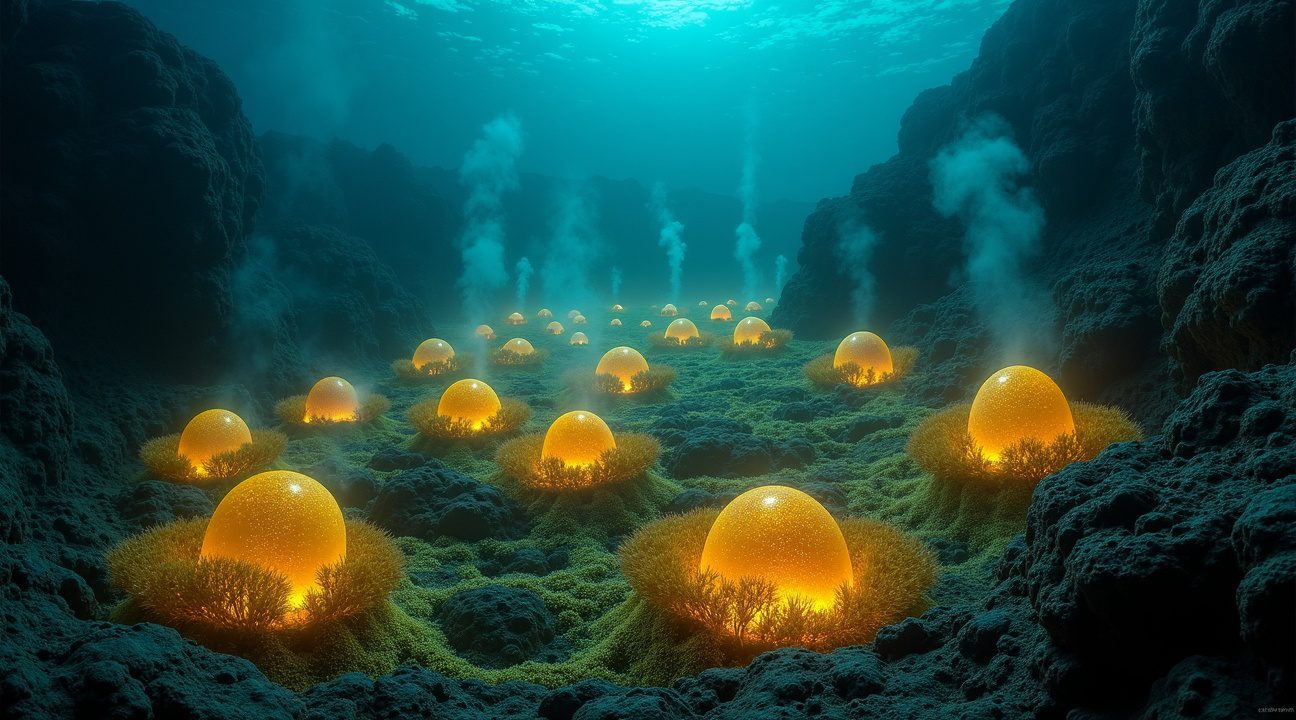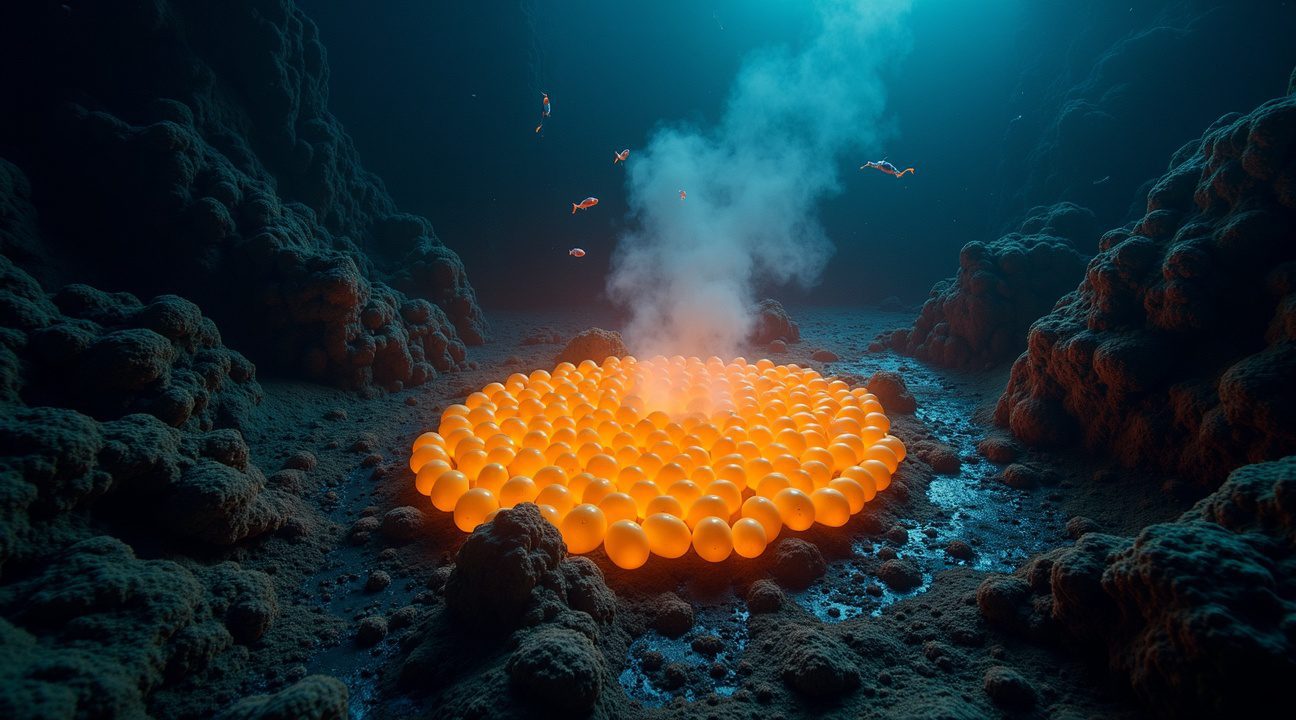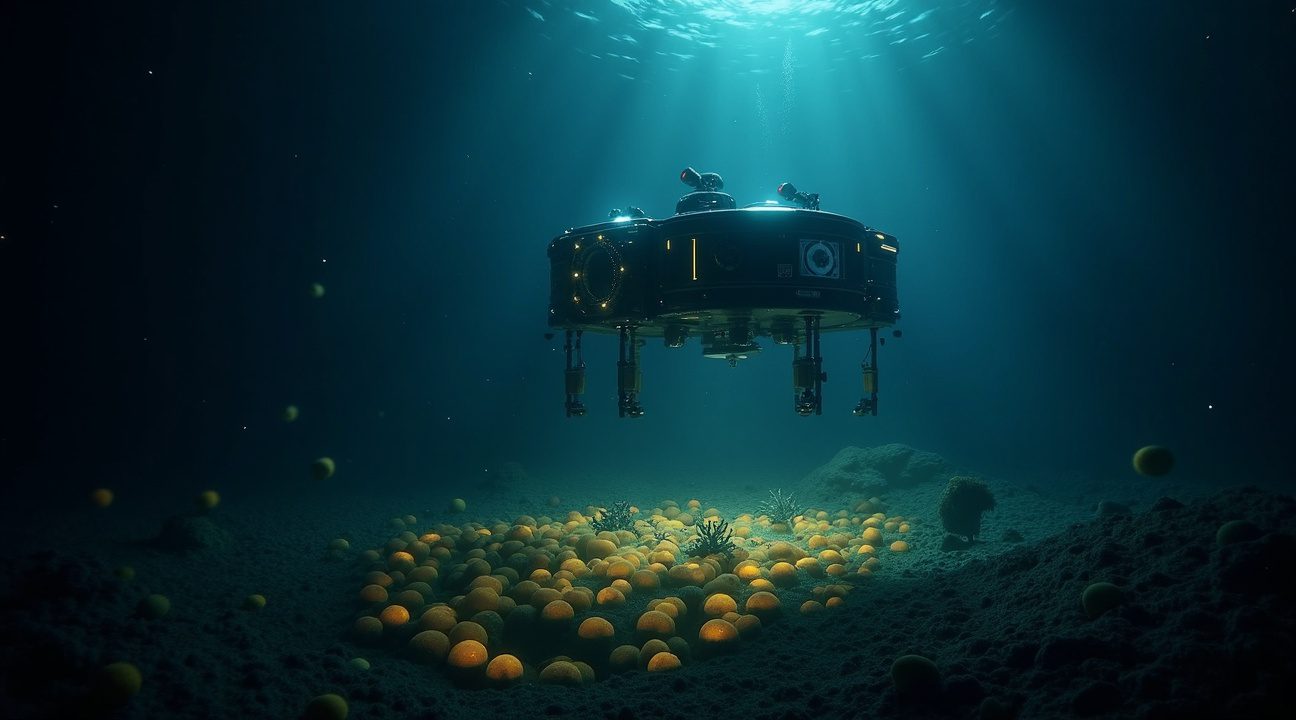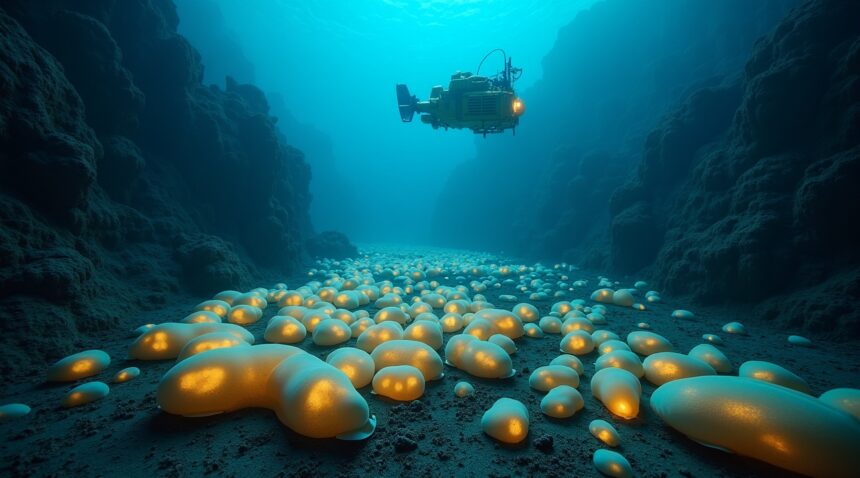Scientists have discovered a remarkable concentration of 2.6 million golden eggs clustered around hydrothermal vents near an underwater volcano off Vancouver Island, deep in the ocean at around 9,500 feet below sea level.
Key Takeaways
- The golden eggs belong primarily to Pacific white skates, deep-sea creatures that can grow over six feet in length and usually need between 4 to 10 years for egg incubation under standard deep-sea conditions.
- Hydrothermal activity from the volcanic vents creates ideal nursery conditions by supplying consistent warmth that drastically shortens the incubation period required for the skates’ eggs to hatch.
- The discovery site, once thought to be a biological dead zone, has become a flourishing reproductive habitat, showcasing how submarine volcanic activity can foster unexpected marine ecosystems.
- Technological advancements, including remotely operated vehicles and sonar mapping, were instrumental in making this significant discovery by allowing access to extreme ocean depths previously unreachable by humans.
- The surprising absence of adult skates at the site points to synchronized reproductive behaviors among the species, and genetic testing is indicating that some of these eggs might come from completely new, unidentified species.
To learn more about how this deep-sea discovery is reshaping marine biology, visit the New York Times article covering the research in detail.
2.6 Million Giant Golden Eggs Found 9,500 Feet Deep Near Pacific Volcano
Scientists made an extraordinary discovery off Vancouver Island when they encountered roughly 2.6 million golden eggs clustered around hydrothermal vents in the Pacific Ocean. These remarkable specimens were found at an astounding depth of approximately 9,500 feet, where the crushing pressure and eternal darkness create one of Earth’s most extreme environments.
Unprecedented Size and Scale of the Discovery
Each individual egg measures an impressive 18–20 inches in length, making them extraordinarily large compared to typical marine life spawn. The sheer volume of eggs concentrated in this single location represents what researchers believe could be the largest mass spawning event ever documented in deep-sea environments. Similar unusual marine discoveries continue to fascinate scientists, much like recent giant squid sightings that have captured global attention.
The golden coloration of these eggs sets them apart from typical deep-sea discoveries, where bioluminescence and translucent features dominate. This unique pigmentation suggests adaptations to the specific chemical environment surrounding the underwater volcano, where mineral-rich compounds create distinct ecological conditions.
Hydrothermal Vent Environment Creates Unique Habitat
The discovery site features an active geothermal system where superheated, mineral-rich water escapes from the seafloor through hydrothermal vents. This creates an unusual warming zone in an otherwise frigid deep-sea environment, with temperatures reaching levels that support specialized life forms. The chemical composition of these thermal springs includes sulfur compounds, metals, and other minerals that could influence the development and characteristics of marine organisms.
Hydrothermal vents serve as oases of life in the deep ocean, supporting ecosystems that exist independently of sunlight-based photosynthesis. These environments often harbor species found nowhere else on Earth, making them critical for understanding evolutionary adaptation and biodiversity. Recent deep-sea research has revealed numerous extraordinary species, including record-breaking fish discoveries at extreme depths.
The proximity of these golden eggs to an active underwater volcano suggests that volcanic activity may play a crucial role in creating suitable conditions for this massive reproductive event. Volcanic systems often generate the precise temperature gradients and chemical environments that trigger spawning behaviors in deep-sea species.

Pacific White Skate: The Deep-Sea Giant Behind the Golden Treasure
The vast majority of the 2.6 million golden eggs discovered near the underwater volcano belong to a remarkable deep-sea creature known as the Pacific white skate (Bathyraja spinosissima). This impressive species represents one of the ocean’s most fascinating deep-sea dwellers, perfectly adapted to life in the extreme conditions found thousands of feet below the surface.
Pacific white skates are true giants of the deep, capable of growing over six feet in length. These remarkable creatures share ancestry with sharks and rays, belonging to the cartilaginous fish family that has dominated ocean depths for millions of years. Unlike their shallow-water relatives, these skates have evolved specifically for life in the crushing darkness of the deep sea, typically inhabiting depths reaching up to 9,500 feet.
The discovery site’s unique characteristics make it an ideal nursery for these deep-sea giants. Pacific white skates lay their eggs in large, nutrient-rich capsules that scientists commonly refer to as “mermaid’s purses” due to their distinctive appearance and protective function. These deep-sea adaptations showcase millions of years of evolutionary refinement for survival in extreme environments.
Extended Incubation and Volcanic Acceleration
Under normal deep-sea conditions, Pacific white skate eggs require an extraordinarily long development period. The incubation period typically ranges from four to ten years, making them among the longest-developing embryos in the animal kingdom. This extended timeline reflects the challenging conditions of deep-sea life, where cold temperatures and limited resources slow biological processes to a crawl.
However, the volcanic activity near this particular discovery site appears to be dramatically altering this natural timeline. Scientists believe the hydrothermal heat emanating from the underwater volcano may significantly accelerate the incubation process. This thermal boost could potentially reduce development time by years, creating optimal conditions for mass reproduction that rarely occur in the deep ocean.
The implications of this accelerated development are profound for understanding deep-sea reproduction patterns. While researchers have observed similar phenomena near other hydrothermal systems, the scale of this discovery suggests something truly exceptional is occurring. The consistent warmth provided by volcanic activity creates a reliable nursery environment that these skates have learned to exploit.
Current genetic testing efforts aim to determine whether other species may also be represented among the golden egg collection. While Pacific white skates appear to dominate the site, the possibility exists that other deep-sea species have also recognized the advantages of this geothermally heated nursery area. Scientists continue analyzing DNA samples to identify any additional species that might be utilizing this unique reproductive haven.
The protective mermaid’s purse structure serves multiple crucial functions beyond simple containment. These leathery cases provide physical protection from predators and environmental hazards while allowing for gas exchange necessary for embryonic development. The cases also contain concentrated nutrients that sustain the developing skate throughout its extended incubation period.
This discovery represents more than just a remarkable census of deep-sea reproduction. It demonstrates how marine life adapts to exploit even the most extreme environments for survival advantage. The Pacific white skates have essentially discovered a natural incubator that could revolutionize their reproductive success in an otherwise harsh environment.
Research teams continue monitoring the site to understand long-term patterns and success rates of this unique nursery. The data collected from this extraordinary finding will provide invaluable insights into deep-sea reproduction, thermal adaptation, and the complex relationships between geological activity and marine life cycles.
Underwater Volcano Transforms from Death Zone to Natural Incubator
Scientists initially believed this underwater volcano was completely dormant and far too cold to support any form of life. The extreme depths and frigid temperatures created what researchers classified as a biological dead zone. However, recent discoveries have revealed a dramatic transformation that challenges previous assumptions about deep-sea volcanic environments.
Hydrothermal Activity Creates Optimal Conditions
The volcano has awakened with hydrothermal activity that’s generating substantial warmth throughout the surrounding seafloor. This geothermal energy is fundamentally altering the local ecosystem by creating temperature zones that support biological processes. The heat produced by volcanic processes appears to be significantly reducing the skates’ incubation time, allowing embryos to develop much faster than they would in the typical freezing deep-sea conditions.
Temperature regulation becomes critical for successful reproduction in these extreme environments. The consistent warmth from hydrothermal vents provides an energy-efficient solution for egg development. Embryos that might take years to mature in standard deep-sea temperatures can now complete their development cycles in considerably shorter timeframes. This acceleration gives the young skates a substantial survival advantage by reducing their vulnerability period.
Strategic Reproductive Adaptation
The strategic placement of 2.6 million eggs near these hydrothermal vents demonstrates a sophisticated reproductive adaptation that scientists rarely observe at such massive scales. Adult skates are actively seeking out and utilizing these environmental energy sources to optimize their offspring’s chances of survival. This behavior suggests an evolutionary response that maximizes reproductive success by leveraging available geothermal resources.
The phenomenon represents a remarkable example of how marine species can adapt their reproductive strategies to exploit changing environmental conditions. Rather than simply depositing eggs randomly across the seafloor, these skates have concentrated their reproductive efforts in areas where volcanic activity provides the most beneficial conditions. Deep-sea research continues to reveal surprising adaptations in extreme environments.
This concentrated egg deposition also creates a unique microhabitat that supports additional species beyond the egg-laying skates themselves. The increased biological activity attracts scavengers, predators, and other organisms that wouldn’t typically inhabit such deep volcanic areas. The transformation has created a complex food web where marine life thrives in conditions previously thought uninhabitable.
The diversity of species now documented in this area includes various invertebrates, small fish, and microorganisms that benefit from both the warmth and the organic matter provided by the developing eggs and hatching skates. This biological hotspot demonstrates how geological activity can rapidly create new ecological niches in the deep ocean.
Scientists are particularly fascinated by how quickly this transformation occurred and how efficiently the skate population responded to the changing conditions. The discovery challenges existing models of deep-sea reproduction and suggests that marine species may be more adaptable to environmental changes than previously understood. Scientific discoveries like this continue to reshape our understanding of life in extreme environments.
The volcano’s evolution from a sterile environment to a thriving biological nursery highlights the dynamic nature of deep-sea ecosystems. This natural incubator now represents one of the most significant concentrations of developing marine life ever documented at such depths, providing researchers with unprecedented opportunities to study reproductive strategies in extreme underwater environments.
The Spawning Mystery: Where Are All the Adult Skates?
The discovery of 2.6 million golden eggs raises a fascinating biological puzzle that has researchers scratching their heads. Scientists found themselves facing an unprecedented scenario — evidence of massive reproductive activity without a single adult skate visible in the area. This phenomenon suggests either a perfectly timed mass spawning event occurred just before the research team arrived, or these elusive creatures possess reproductive behaviors far more complex than previously understood.
Coordinated Reproduction Without the Participants
The sheer volume of eggs indicates a highly coordinated reproductive effort that likely involved hundreds or thousands of adult skates. I find it remarkable that such a massive biological event could occur with such precision that no adults remained by the time scientists arrived to document it. This timing suggests these deep-sea creatures might follow specific environmental cues — perhaps related to volcanic activity, seasonal temperature changes, or lunar cycles — that trigger synchronized spawning events.
Modern technology finally allowed researchers to access these extreme depths and witness this phenomenon firsthand. Advanced remotely operated vehicles equipped with high-definition cameras provided the tools necessary to explore areas previously beyond human reach. Similarly, sophisticated sonar mapping systems enabled scientists to create detailed topographical maps of the volcanic terrain where these eggs were discovered.
Ongoing genetic analysis adds another layer of intrigue to this mystery. Laboratory tests suggest some eggs might belong to entirely new species — deep-sea skates that science hasn’t yet identified or catalogued. This possibility transforms the discovery from simply impressive to potentially groundbreaking for marine biology. Each egg represents not just reproductive success but possibly an unknown branch of the skate family tree.
The breakthrough moment came in 2023 when researchers captured the first-ever live footage of a female skate actively laying eggs in deep-sea conditions. This historic recording provided scientists with real-time insight into behaviors that had remained hidden for centuries. The footage revealed intricate egg-laying rituals and positioning behaviors that help explain how such massive concentrations of eggs could accumulate in specific locations.
These observations challenge traditional assumptions about deep-sea reproductive patterns. Previously, scientists believed skate reproduction occurred sporadically across vast ocean areas. The discovery near the underwater volcano suggests instead that certain geological features might serve as preferred nursery sites, attracting multiple species and generations of skates to deposit their eggs in the same protective environment.
The volcanic setting itself provides crucial clues about this reproductive mystery. Underwater volcanoes create unique microenvironments with specific temperature gradients, chemical compositions, and current patterns that might be ideal for egg development. The volcanic activity could provide the perfect combination of warmth and mineral-rich water that developing skate embryos require for successful hatching.
Temperature regulation appears particularly critical for these golden eggs. The consistent heat generated by volcanic vents likely maintains optimal incubation conditions that would be impossible to find in the surrounding deep-sea environment. This natural incubator theory explains why skates might travel considerable distances to reach this specific location for reproduction.
The absence of adult skates at the discovery site also suggests highly efficient reproductive strategies. These creatures likely arrive, complete their spawning activities, and quickly disperse to avoid predation or competition for limited food resources. This hit-and-run approach to reproduction maximizes offspring survival while minimizing adult exposure to potential threats.
Research teams continue analyzing water samples and egg specimens to understand the complete reproductive cycle of these mysterious deep-sea inhabitants. Each piece of data brings scientists closer to solving this spawning puzzle and understanding how life thrives in Earth’s most extreme underwater environments.
https://www.youtube.com/watch?v=INSERT_VIDEO_ID_HERE
Life Thrives Where Scientists Least Expected It
The discovery of 2.6 million golden eggs clustered around an underwater volcano has shattered conventional wisdom about life’s boundaries in Earth’s most extreme environments. I’ve watched as this finding forces marine biologists to reconsider their fundamental assumptions about where complex life can flourish, particularly in areas previously dismissed as biological wastelands.
Geothermal Niches Support Complex Reproductive Strategies
These deep-sea egg masses reveal how marine species exploit geothermal energy to sustain sophisticated breeding behaviors in environments that should theoretically be hostile to life. The eggs’ proximity to volcanic vents suggests that parent species deliberately choose these locations for their reproductive cycles, taking advantage of the stable temperatures and unique chemical conditions that hydrothermal systems provide.
I find it remarkable how these organisms have developed reproductive strategies that turn extreme conditions into advantages. The volcanic environment offers consistent warmth in the frigid deep ocean, creating microhabitats where embryonic development can proceed at optimal rates. Recent research into deepest marine environments continues to reveal similar adaptations that challenge our understanding of life’s limits.
Chemical gradients around volcanic vents create diverse ecological niches within relatively small areas. Parent species likely select specific zones based on precise temperature ranges, chemical compositions, and current patterns that optimize their offspring’s survival chances. This level of environmental discrimination demonstrates sophisticated behavioral adaptations that scientists hadn’t previously documented in deep-sea species.
Underwater Volcanoes as Biodiversity Sanctuaries
This discovery positions underwater volcanic regions as critical biodiversity hotspots that may harbor numerous undiscovered species. I see these environments functioning as evolutionary laboratories where extreme selective pressures drive rapid adaptation and speciation. The isolation of volcanic vents creates island-like ecosystems that can support endemic species found nowhere else on Earth.
Scientists now recognize that these supposed “death zones” actually serve as refuges for rare species that can’t survive in more conventional marine environments. The unique conditions around underwater volcanoes provide ecological stability over geological timescales, allowing complex ecosystems to develop and persist despite their apparent inhospitality.
The protective value of these environments becomes even more significant when considering climate change impacts on marine ecosystems. Deep-sea volcanic areas may serve as climate refuges where species can maintain stable populations while surface conditions fluctuate dramatically. Research into phenomena like brain function mysteries shows similar patterns of unexpected discoveries challenging established scientific thinking.
Conservation implications extend far beyond protecting individual species. These ecosystems represent irreplaceable evolutionary archives that document how life adapts to extreme conditions over millions of years. Damage to volcanic vent communities could eliminate entire lineages before scientists have opportunities to study their unique adaptations and evolutionary histories.
The discovery also highlights how little scientists still know about deep-sea biodiversity. If 2.6 million eggs can remain undetected around a single volcanic site, countless other discoveries likely await in similar environments worldwide. Each new finding reinforces the urgent need for comprehensive deep-sea exploration and protection efforts.
Scientists must now reassess their approaches to marine conservation, expanding protected area designations to include these previously overlooked volcanic ecosystems. The fragility of these environments, combined with their apparent biological importance, demands immediate attention from both researchers and policymakers.
Space exploration parallels emerge when considering how these discoveries reshape scientific perspectives. Just as Saturn’s moon research reveals unexpected possibilities for life beyond Earth, underwater volcanic discoveries demonstrate how terrestrial life exceeds scientists’ most optimistic predictions for biodiversity and adaptation.

Revolutionary Deep-Sea Technology Unlocks Ocean’s Secrets
Modern remotely operated vehicles (ROVs) and advanced sonar mapping technologies have transformed how I examine the ocean’s most mysterious depths. These sophisticated systems allow researchers to venture into regions once deemed completely inaccessible, reaching areas where human presence would be impossible. ROVs equipped with high-definition cameras and precision sampling tools can navigate through complete darkness while withstanding crushing pressures that would destroy conventional equipment.
The extreme conditions at 9,500 feet below the surface present formidable challenges that require specialized engineering solutions. Temperatures hover near freezing, while water pressure reaches levels over 290 times greater than at sea level. Advanced sonar mapping creates detailed three-dimensional maps of the seafloor, revealing geological features and potential sites of interest before ROVs make their descent. This technology proved instrumental when researchers found the deepest fish ever recorded in similar extreme environments.
Cutting-Edge Equipment Capabilities
Recent technological advancements have equipped deep-sea exploration vehicles with capabilities that exceed previous limitations. These systems feature:
- Reinforced titanium hulls designed to withstand extreme pressure differentials
- Advanced LED lighting arrays that illuminate vast areas of the ocean floor
- Precision robotic arms capable of collecting delicate samples without damage
- Real-time data transmission systems that relay information to surface vessels
- Extended battery life allowing for missions lasting up to 20 hours continuously
The equipment used in discovering the 2.6 million golden eggs demonstrates how far deep-sea technology has progressed. High-resolution cameras captured unprecedented footage of this massive nursery, while specialized sampling tools collected specimens for detailed analysis. Temperature sensors and chemical detection equipment gathered environmental data that helps scientists understand the unique conditions supporting such extraordinary marine life.
These technological breakthroughs have made it possible to document behaviors and phenomena that were previously unknown to science. ROVs can hover motionless for extended periods, observing marine life without disturbing natural activities. The ability to return repeatedly to specific locations allows for long-term studies that track changes in deep-sea ecosystems over time. Each mission generates terabytes of data that contribute to our understanding of ocean environments and the remarkable creatures that inhabit them.

Sources:
Greater Good Science Center – Scientists Find Millions of Golden Eggs Hidden in Deep Sea
Vocal Media – 2.6 Million Golden Eggs Found Near Underwater Volcano
Mr Scientific (YouTube) – [Video content]
Times of India – Scientists Discover Millions of Glowing Golden Eggs in the Deep Sea
Sustainability Times – 2.6 Million Golden Eggs: Secret Volcano Nursery Uncovered as Alien-like Marine Species Breeds in Ice-Cold Death Zone
Earth.com – Giant Fish Species Lays Its Golden Eggs in an Underwater Volcano


